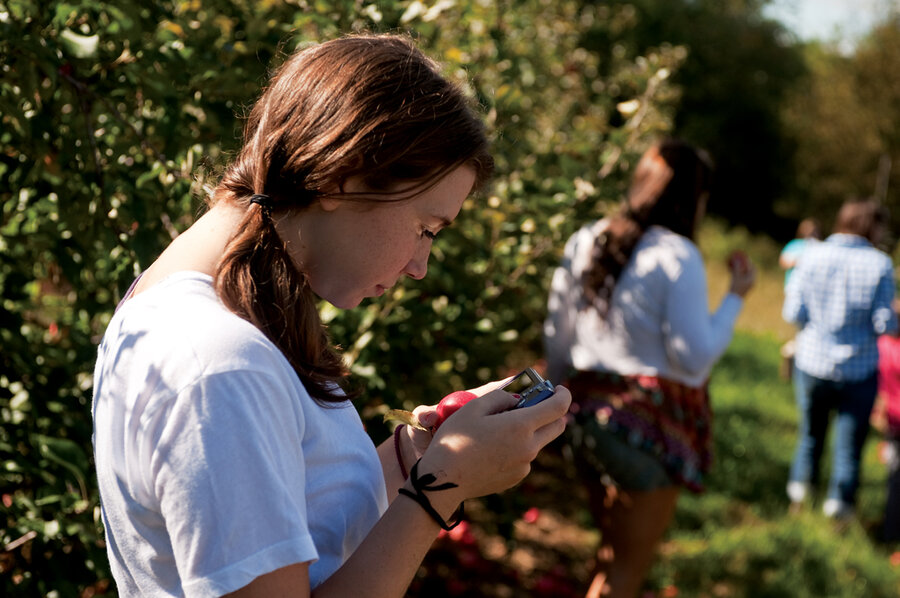Economy 2.0? Meet 'ifarmers' – they plant, tweet
Loading...
| Concord, Mass.
JeffFowle: "Back to baling again. Dew is perfect! #hay10 #agchat"
TroyBeast: @JeffFowle "you're baling hay at one in the morning?!"
At any time of day or night, Jeff Fowle is liable to whip out his Android smart phone and post a message to his growing base of readers. It can be about raising Angus cattle and Percheron draft horses; irrigation problems on his Etna, Calif., ranch; politics; or the reason he bales hay around midnight when the dew is uniform but not too heavy. He tweets from his office, his tractor, even from horseback.
"I can ride my horse w/o hands and bridle," explains Mr. Fowle via Twitter, where he has 24,000 followers. (He also posts on Facebook, Buzz, and other social media.) "All leg and seat position and pressure."
The fourth-generation farmer and rancher is part of a growing coterie of "ifarmers," who are using new media to communicate with consumers and other farmers directly. Many use it to build their business. Fowle started using social media last year to educate people about agriculture and, as he phrases it, "put a face back on the plate." By reconnecting with consumers, ifarmers are personalizing a food chain that over decades has grown more complex, globalized, and impersonal.
"Twitter's wide-open platform allows farmers to have conversations on a global basis, regardless of the subject," reports Michele Payn-Knoper, founder of the AgChat Foundation and whose "#agchat" forum on Twitter has attracted more than 2,500 people from nine countries since its inception in April 2009.
It wasn't a business plan that convinced the Verrill family to push into new media, it was a disaster. When fire destroyed the family's Concord, Mass., farm store in 2008, so many distraught customers came by to offer condolences that the family decided to reach out to customers online. [Editor's note: This sentence was changed to correct the year of the fire.] By the time they reopened a year later, the Verrills already had a blog following and a Twitter feed. Today, more than 1,000 people follow @VerrillFarm's tweets about produce from the 100-acre farm and value-added treats made in their kitchens or by other local businesses.
Social media is just one form of outreach. After a recent tweet promoted their variety of fresh-picked pumpkins, customers flooded the farm stand. "Hard to say if the tweet had an effect on pumpkin sales," says John Walker, social-media coordinator for Verrill Farm. "We were slammed on Saturday, but can't put a finger on why."
Many farmers are beginning to use the medium. In 1997, 13 percent of US farmers engaged in e-commerce, says Peter Stenberg, an economist at the US Department of Agriculture (USDA). Today, 33 percent do, including John Wood, of US Wellness Meats.
Inspired to promote health, the fifth-generation Missouri farmer changed his work methods, switching his 300-acre farm from conventional livestock production to grass-fed beef in 2000. He launched a website to reach consumers, but it did not increase his clientele. Realizing he needed to educate people about the benefits of grass-fed beef, Mr. Wood formed alliances with wellness doctors and others and hired a consultant who helped him get into social media. "People didn't even know what grass-fed beef is," he says. "Now they do. It's been a long, slow process, and it's a paradigm shift."
While larger operations sometimes designate a farm employee to handle social media communication, Gail VanWart of Peaked Mountain Farm in Dedham, Maine, keeps her hands in every aspect of the family business. She offers her 1,800-plus Twitter followers up-to-the-minute posts about wild blueberry farming, the farm's signature blueberry dog treats that sell nationally, new products, and TwitPics of her dog, Blae, rooting around the blueberry fields. In return, followers of @PeakedMtFarm send words of support, and retweet to help spread information.
An iPhone junkie, Ms. VanWart takes her smart phone along and conducts business while harvesting. "There is an app for everything that I need to do," she explains in an e-mail. "I can send and receive faxes and take a phone call from people who still order the old-fashioned way, scan items with my phone, and accept credit-card charges."
Ifarming is still a small slice of agribusiness. On a wholesale level, only about 4 percent of farm product sales was conducted online in 2006, about $5 billion worth, according to the USDA. On the retail level, ifarmers aren't going to challenge Wal-Mart or Kroger anytime soon. Still, by sharing their personal stories and educating people about farming one tweet at a time, ifarmers are forging relationships and reconnecting customers with a food system that has grown distant with the addition of food processors and multiple wholesalers and grocers and whose stories are told secondhand in the media rather than by farmers themselves.
"Social media has created a bridge between consumers and producers," Fowle writes in an e-mail. "For too long, we in agriculture have relied upon industry organizations to tell our story and Main Stream Media has carried negative stories, while those of us growing the food, fiber, fuel and shelter have remained silent. S[ocial] M[edia] has provided us an opportunity to find our voice, [and] tell our own story."






